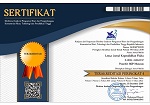PENGARUH METODE PEMECAHAN MASALAH MELALUI DEMONSTRASI UNTUK MENINGKATKAN HASIL BELAJAR SISWA SMKN 03 MATARAM
DOI:
https://doi.org/10.33394/j-lkf.v3i1.380Keywords:
Problem-solving methods, a demonstration, learning outcomesAbstract
This study aims to determine the effect of problem-solving methods through a demonstration of student physics learning outcomes. Research has been done on X level students in high school. The research method used is experiment. The number of samples is 46 students taken from two classes that have the same initial ability. The data obtained is taken from the post-test value. The research hypothesis was tested by using t test statistic. The result of t-test analysis on the learning process shows the value of t-test = 1.740 is greater than t-table = 1.694 (1.740> 1.694). Therefore, Ho is rejected and Ha is not rejected. We conclude that the use of teaching materials using problem-solving methods through demonstrations has a positive impact on student success.
References
Faturahman, 2007. Belajar dan Faktor-Faktor yang Mempengaruhinya. Jakarta: PT. Rineka Cipta.
Bahtiar dan Prayogi, S. 2011. Evaluasi Hasil Pembelajaran Sains (IPA). Mataram: Dimensi Raya.
Arikunto, Suharsimi. 2010. Prosedur Penelitian Suatu Pendekatan Praktik. Jakarta: PT. Rineka Cipta.
Sugioyono. 2010. Metode Penelitian Pendidikan pendekatan Kuantitatif, Kualitatif dan R&D. Bandung: Alfabet.
Trianto, 2007. Metode Penelitian Pendidikan. Bandung: Alfabet.
Nurhadi, 2003. Belajar dan Pembelajaran. Jakarta: Rineka Cipta.
Subando. 2008. Evaluasi Pendidikan. Bandung : Bumi Aksara.
Downloads
Published
How to Cite
Issue
Section
License
Authors who publish with Lensa: Jurnal Kependidikan Fisika agree to the following terms:
- For all articles published in Lensa: Jurnal Kependidikan Fisika, copyright is retained by the authors. Authors give permission to the publisher to announce the work with conditions. When the manuscript is accepted for publication, the authors agree to automatic transfer of the publishing right to the publisher.
- Authors retain copyright and grant the journal right of first publication with the work simultaneously licensed under a Creative Commons Attribution-ShareAlike 4.0 International License that allows others to share the work with an acknowledgment of the work's authorship and initial publication in this journal.
- Authors are able to enter into separate, additional contractual arrangements for the non-exclusive distribution of the journal's published version of the work (e.g., post it to an institutional repository or publish it in a book), with an acknowledgment of its initial publication in this journal.
- Authors are permitted and encouraged to post their work online (e.g., in institutional repositories or on their website) prior to and during the submission process, as it can lead to productive exchanges, as well as earlier and greater citation of published work (See The Effect of Open Access).

This work is licensed under a Creative Commons Attribution-ShareAlike 4.0 International License.



